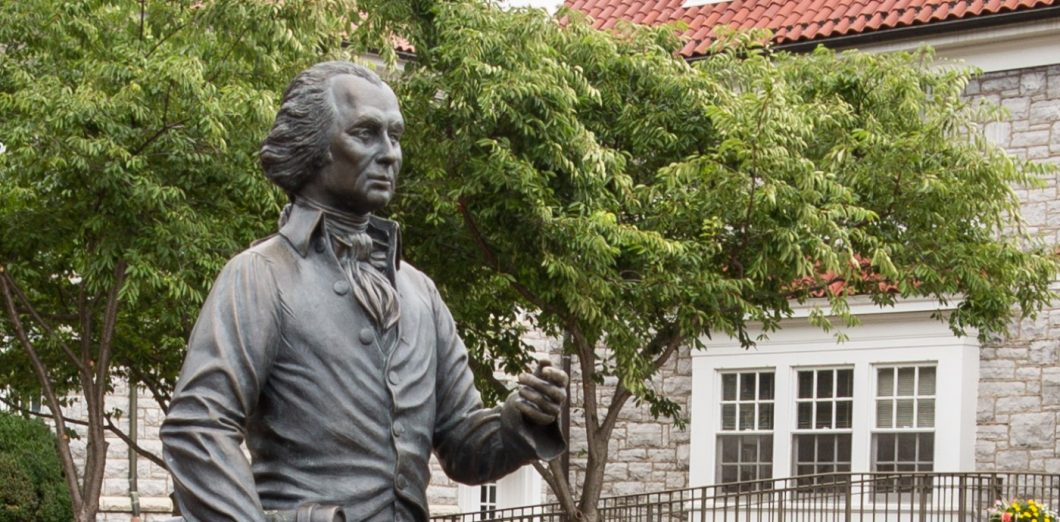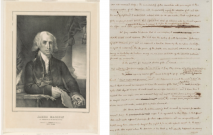James Madison, Politico
Jay Cost’s new biography, James Madison: America’s First Politician, stresses the relationship between the Founder’s political science and his practical politics. This approach yields fresh insights, and the reader is left with the clear impression that Madison struggled mightily to reconcile his practical statesmanship with his ingenious political science.
In his preface, Cost explains that “To create a full portrait of Madison, we must connect his constitutional theory to his career in government,” which he puts in the context of the novel theoretical problem posed by the fledgling United States: as the country was too large for direct democracy in the Athenian mode and did not have the social materials for balancing the one, the few, and the many as the British Constitution did, how could the United States have free government? Madison’s solution was to turn Montesquieu on his head: to make a virtue of necessity by insisting that in the absence of classic social orders, not a relatively small polis but a large federation of republican states provided the best materials for republican government. Cost summarizes this familiar Madisonian reasoning clearly.
Already at this point a significant omission from Cost’s account appears, as Cost limns the split between Madison and Alexander Hamilton over the latter’s program in the 1790s, then traces Madison’s objection to what Hamilton was doing to a principle that “in a republic the benefits and burdens of policy should be evenly distributed across the populace.” Missing from this explanation is Madison’s insistence that the Constitution must be interpreted as it had been understood by the ratification conventions that gave it force—among which the Virginia Ratification Convention of 1788, in which Madison had been a leading participant, held the foremost place in his mind. Hamilton’s Treasury Department program ran up against the various assurances about the way the Constitution would be read made by leading Federalist spokesmen in various states, notably by Gov. Edmund Randolph and George Nicholas, not to mention Madison himself, in the Richmond Convention. In lieu of this principle, Cost offers “his commitment to a neutral government that advanced the public interest, treated citizens equitably, and respected individual rights” as “the through line of his public life.” This early development in Cost’s account, which will reappear repeatedly as the story progresses, paves the way for Cost’s conclusion that Madison was a constitutional precursor to Abraham Lincoln and Ulysses S. Grant. He even traces their advocacy of internal improvements to Madison, despite, for example, Madison’s famous Bonus Bill Veto Message of 1817—which other historians have seen as a kind of constitutional valedictory address.
Chapter One, “Born for Politics,” explains how James Madison, Jr.’s family came to be the preeminent family in Orange County, Virginia and shows what that meant. The chief beneficiary of his father’s wealth in his generation, James, Jr. received both superlative education in his youth and financial support through the first half-century of his life. Though the election of 1800, which led to Thomas Jefferson’s presidency, and thus Madison’s tenure as secretary of state, passed before Madison owned his own abode, his connections meant that he stood well up in the Virginia squirearchy: prominent politicians active in his lifetime to whom he was related by birth included Edmund Pendleton and John Taylor of Caroline, among others. (Madison’s maternal Taylor link means that President Zachary Taylor was a Madison cousin, as was Taylor’s son-in-law Jefferson Davis.)
Here is what Cost means by referring to Madison as “America’s First Politician”: While in Virginia, at least, politics was generally an occasional occupation of the well-off, James, Sr.’s willingness to pay his son’s living expenses afforded Our Hero the opportunity to devote himself to politics full-time on an ongoing basis. This made it possible for Madison to earn a reputation as the best-prepared man in context after context—including, most famously, the Philadelphia Convention of 1787.
Cost lays the groundwork for Madison’s political career by describing the education he received in Virginia and at Princeton. The tutelage of John Witherspoon and, in particular, the writings of David Hume seem to have affected Madison’s politics, as the churchman’s Calvinism and the Scottish skeptic’s jaundiced view of humanity would guide the Virginian lawgiver.
The final essential support of James Madison’s career was his close friendship with the senior Piedmont Virginia statesman, Thomas Jefferson. Not only did the two share common political principles, but they had similar personalities. Jefferson too was bookish and preferred small groups to large, and across virtually the entirety of their half-century relationship, this most influential of American political tandems helped republicanize the Old Dominion and the federal Union. By the story’s end, Madison as surviving partner would put his back into the task of living up to Jefferson’s request to “take care of me when dead.”
Madison did play a role in the drafting of the Virginia Declaration of Rights in 1776, but Cost omits the parenthetical inserted into George Mason’s draft of Section 1 by the entire Virginia Convention, which said government was only responsible for protecting men’s rights “when they enter into a state of society” (thus excluding slaves). While he shows Madison acting to commit Virginia to the “free exercise” of religion instead of the Mason committee draft’s “toleration,” Cost misses this pro-slavery amendment to which no one (including Madison) objected.
What Cost sees in the “free exercise” tale, beyond the epochal principle Madison vindicated, is a first step in support of the more general idea that, as he puts it, “the government should not play favorites but rather act as a neutral arbiter that seeks to balance the interests of the various forces in society,” absent which “injustice and corruption were sure to follow.” In this account, the insistence that government not play favorites accounts for Madison’s distaste for Alexander Hamilton’s program as secretary of the treasury. Though Cost assumes Hamilton did not have the goal of doing so, his proposals for assumption of state debts, establishment of a national bank, direct support of particular industrial concerns, etc., favored wealthy, connected residents of the large northern towns—Philadelphia, New York, and Boston. Here is what Madison found most galling about them, we are told.
This account downplays the constitutional arguments in which congressional, Cabinet, and journalistic opposition to the several aspects of Hamilton’s program was couched. From this account of Madison, one takes the idea that though the Republican Party of Jefferson, Madison, and their allies insisted that the Federal Government had only the enumerated powers, Madison did not think that point particularly important. Cost consistently slights (usually by omission) Madison’s concern to maintain fidelity to vows about limited central government—federalism—Federalists had made during the ratification campaign.
The most interesting section of this book in relation to Madison and federalism is the chapter on the Virginia and Kentucky Resolutions of 1798-99 and Report of 1800. Here Cost tells the story of Madison’s role in Republican states’ formal response to the Alien and Sedition Acts of 1798 as it has long been told. The Virginia and Kentucky legislatures in 1798 adopted formal resolutions, drafted by Madison and Jefferson respectively, saying that the states had a final supervisory power over the constitutional behavior of the Federal Government. Yet, overstepping the limits of their constitutional authority, Virginia and Kentucky found themselves without support from other states. Madison’s Virginia Resolutions, the tale went, were more moderate than Jefferson’s Kentucky version, which claimed for the states power to take action that would have violated the Supremacy Clause. Only a few people were prosecuted under the Alien and Sedition Acts anyway, and the Revolution of 1800 put an end to Federalists’ suppression of their Republican opponents.
The Virginia Resolutions did not invoke “the sovereign rule of the people of the United States,” but instead noted that Virginia “views the powers of the federal government, as resulting from the compact to which the states are parties”—that is, they looked not to a national, but to a federal union.
Cost says that Jefferson/Kentucky’s claim that the Alien and Sedition Acts “were unconstitutional ‘and thus altogether void and of no force, and that the power to create, define, and punish such other crimes is reserved, and of right appertains solely and exclusively to the respective states, each within its own territory’” was more radical than the Virginia Resolutions and ran up against the Supremacy Clause, “which established federal laws above state laws.” In reality, Jefferson understood “unconstitutional” and “void and of no force” as a redundancy, and the Supremacy Clause, which by its terms applies only to constitutional laws, is irrelevant to the question how states may respond to unconstitutional laws. The bit about states’ reserved power is also a tautology, this time reflecting a Jeffersonian understanding of the Tenth Amendment. In other words, Jeffersonians in Kentucky, besides in Virginia, Georgia, Tennessee, South Carolina, and elsewhere, did not see this language as radical at all. (This is not to deny that Jefferson said truly radical things about states’ reserved powers from time to time, as I have developed elsewhere.)
Madison’s Report of 1800, adopted by the House of Delegates in response to northern criticisms of the Virginia Resolutions, did indeed try to make the Virginia version seem more moderate than Kentucky’s. What Cost misses, however, is that the Virginia Republicans had agreed to excise the “offending” language in 1798 on the ground that once a law was called “unconstitutional,” the rest followed. Madison was not a member of the House of Delegates in 1798, and John Taylor of Caroline, the Virginia Resolutions’ sponsor, was if anything a more radical proponent of state interposition than Jefferson. He did not think that removing redundant language made the Virginia Resolutions less strident. (We should note too that the General Assembly of 1798 also built a new state armory in Richmond—even as prominent Virginia congressman William Branch Giles publicly floated the idea of secession. Old Dominion Republicans seemingly were unconcerned with seeming strident.)
Cost is right that Madison was more moderate in 1800 than other leading Virginia Republicans, but he goes too far in arguing so. For example, he says that Madison “reject[ed]…any judicial authority of the states over federal laws,” which is just mistaken: state courts in every state enforce federal laws every day, and they sometimes hold them unconstitutional. Per the Supreme Court’s reasoning in Marbury v. Madison (1803), the Supremacy Clause obliges them to do so. Madison did not deny this.
Thanks to Wendell Bird’s Criminal Dissent, the relevant findings of which were published in a scholarly journal years ago, we now also know that Virginia and Kentucky were not isolated in their stand in 1798. They had the formal support of the legislatures of Georgia and Tennessee, besides one house of North Carolina’s, and would have had that of South Carolina’s if the Virginia Resolutions had reached it prior to the last day of that year’s session. Far from the “political disaster” Cost describes, then, the Virginia and Kentucky Resolutions seem to have been successful in rallying the South (at least) to the Republican cause.
Cost concludes this discussion by saying that Madison “was committed to the sovereign rule of the people of the United States, in accordance with the principles of justice and equity.” Here he looks forward to Madison’s position during the Nullification Crisis and to Abraham Lincoln’s admiration of what Madison said then. The Virginia Resolutions of 1798, however, did not invoke “the sovereign rule of the people of the United States,” but instead noted that Virginia “views the powers of the federal government, as resulting from the compact to which the states are parties”—that is, they looked not to a national, but to a federal, union. This is the thread that ties together Madison’s role in drafting the First and Tenth Amendments, his opposition to various Hamiltonian proposals, his Bonus Bill Veto Message, and various of his other actions as a federal officeholder. It also underlay his criticism of John Marshall’s opinion in McCulloch v. Maryland.
Cost introduces the matter of Madison’s record regarding slavery in his preface. Madison, he says, never asserted “his vast powers” in an attempt to blaze a trail away from slavery in either Virginia or federal politics. He elsewhere asserts that though the antislavery impulse began to be felt in his lifetime, “Madison was never to be counted among” those whom it affected and that Madison “never did anything of substance to help African Americans” live free. Cost perhaps has judged Edward Coles’s assertion that Madison and Dolley had agreed Dolley would free the family slaves in her will unpersuasive, but surely Madison’s longtime participation in the American Colonization Society (ACS), a civic institution with the goal of transporting American freedmen to Africa, deserves mention. Madison served the ACS as a state officer and national president, and he left the ACS a substantial sum of money and valuable property in his will. This seems inconsistent with Cost’s accusing Madison of “denying the moral imperative of finding a remedy” for slavery, as does Madison’s reference in correspondence to slavery as an “evil” of “magnitude…so deeply felt, and so universally acknowledged, that no merit could be greater than that of devising a satisfactory remedy for it.” In a passage of his book drawing on the letter here quoted, Cost criticizes Madison for the reasoning that led him to support the ACS, which is strikingly similar to Jefferson’s reasoning on the same question.
In sum, despite some quarrels, I find that Jay Cost has written a thoughtful account of the life of James Madison. The founder and president depicted in it consistently has his eye on systemic implications even as he expertly plays the everyday political game to considerable lasting effect. The reader comes away thinking he has met a Madison he had never quite seen before.


